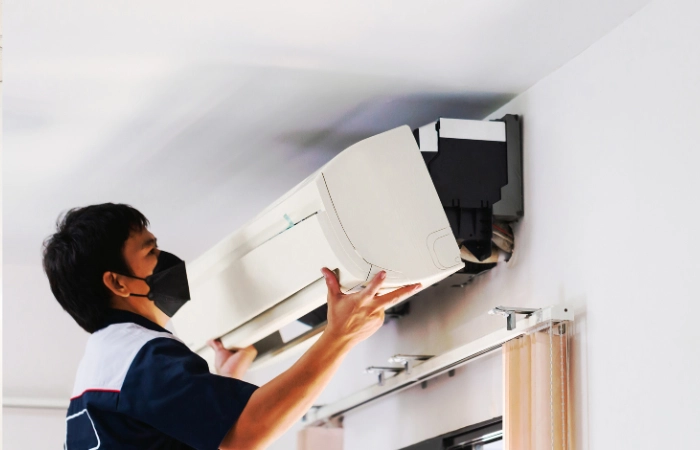Installing a split system in your home is a significant step towards achieving efficient and comfortable indoor air conditioning. Whether it’s your first time considering a split system installation or you’re looking to upgrade your current setup, understanding the essentials of proper installation is crucial.
This article provides valuable insights and quick tips to guide you through the process, ensuring your split system operates optimally. From selecting the right location to understanding the importance of professional installation, we’ve got you covered. Let’s dive into making your home more comfortable with these essential tips for split system installation.
Do I Need to Hire a Professional for Split System Installation?
Yes, hiring a professional for split system installation is highly recommended. Professional technicians have the essential expertise, tools, and experience to ensure that your split system is installed correctly and efficiently. They can also identify any probable issues with your space that could affect the installation process.
Moreover, professional installation ensures that your system operates at peak efficiency, prolongs its lifespan, and complies with warranty requirements. Attempting to install a split system without proper training can lead to costly errors and safety hazards.
Quick Split System Installation Tips
Installing a split system, commonly known as a split system air conditioner, involves several steps and demands attention to detail to ensure efficient operation and longevity. Here are some essential tips to guide you through the installation process:
Choosing the Right Location
The location of your split system’s indoor and outdoor units greatly impacts its efficiency and performance. For the outdoor unit, select a spot shielded from direct sunlight and high debris areas to prevent overheating and blockages. It should also be placed away from windows and neighbors to minimize noise disturbance.
The indoor unit, on the other hand, should be mounted on a wall that allows for unobstructed air distribution across the room. Avoid placing it directly above electronics or in areas where furniture could block airflow.
Ensuring Proper Mounting
Secure mounting of both the indoor and outdoor units is essential for the stability and longevity of your split system. The outdoor unit should rest on a stable, level foundation, such as a concrete pad or secure brackets, to reduce vibration, noise, and the risk of tilting or falling. This base must be resilient against weather conditions and capable of supporting the unit’s weight.
For the indoor unit, mounting it high on the wall, typically 7 to 8 feet from the floor, promotes superior air circulation, allowing for even temperature distribution throughout the room. Ensure the wall can support the unit’s weight and that the mounting brackets are firmly attached to the structure.
Refrigerant Lines Consideration
The refrigerant lines, which connect the indoor and outdoor units, play a critical role in the efficiency of your split system. These lines should be carefully routed, avoiding sharp bends and ensuring they are properly insulated to minimize energy loss. It’s critical to check for leaks, as even minor ones can significantly impact the system’s performance and increase operating costs. Use quality materials for insulation and secure fittings to maintain optimal refrigerant flow. Proper handling and installation of these lines ensure efficient heat exchange and contribute to the longevity of your system.
Electrical Connections
Electrical connections are a critical aspect of split system installation, requiring adherence to local codes and safety regulations. Incorrect wiring can lead to malfunctioning of the system, safety hazards, or even fire risks. It is advisable to employ a licensed electrician to oversee this phase, ensuring that all connections are correctly and safely established.
This includes installing a dedicated circuit breaker for the system and ensuring that the electrical supply matches the unit’s requirements. Proper grounding and secure connections are essential to prevent electrical accidents and ensure reliable operation.
Testing and Commissioning
After the installation is complete, a thorough testing and commissioning process is necessary to ensure the system operates efficiently and safely. This includes checking for refrigerant leaks, verifying that all electrical connections are secure, and ensuring the system responds correctly to the thermostat settings. Testing the airflow and temperature control in different modes (cooling and heating) ensures that the system meets the expected performance criteria.
Additionally, it’s important to familiarize yourself with the system’s maintenance requirements, such as cleaning filters and scheduling professional check-ups, to maintain its efficiency and prolong its lifespan.
Split System Installation FAQs

What is the ideal distance between the indoor and outdoor units of a split system?
The ideal distance between the indoor and outdoor units varies by model but generally should be kept as short as possible, typically around 15 to 30 meters. This minimizes the potential for energy loss and ensures efficient operation. However, still refer to the manufacturer’s guidelines for specific recommendations.
Can I install the indoor unit of a split system in any room of my house?
Yes, you can install the indoor unit in any room, but it’s important to choose a location that allows for optimal air distribution and easy access for AC maintenance. Avoid areas where the unit might be obstructed by furniture or curtains, and ensure it’s placed in a room where you spend a lot of time for maximum comfort benefits.
How often should the refrigerant levels be checked in a split system?
Refrigerant levels in a split system should be checked by a professional at least once every two years or more frequently if you notice a decrease in cooling or heating efficiency. Regular checks help identify leaks early and ensure your system operates efficiently.
Is it necessary to have a stabilizer for my split system air conditioner?
Depending on the stability of your local power supply and the specific requirements of your split system model, a stabilizer may be recommended to protect against voltage fluctuations that can harm the unit. Consult with a professional or your unit’s manufacturer to determine if a stabilizer is necessary for your system.
Conclusion
Following these guidelines for split system installation can significantly enhance your comfort and the efficiency of your home’s air conditioning. By prioritizing professional installation, choosing the right locations, and paying attention to essential installation details, you’ll ensure your split system serves you well for years to come. Remember, a properly installed split system is key to enjoying a cool, comfortable home environment.
For more information on split systems or to schedule an installation with our expert team, contact us at Tropic-air Conditioning inc. We can help you with your HVAC needs, ensuring your home remains comfortable year-round.




